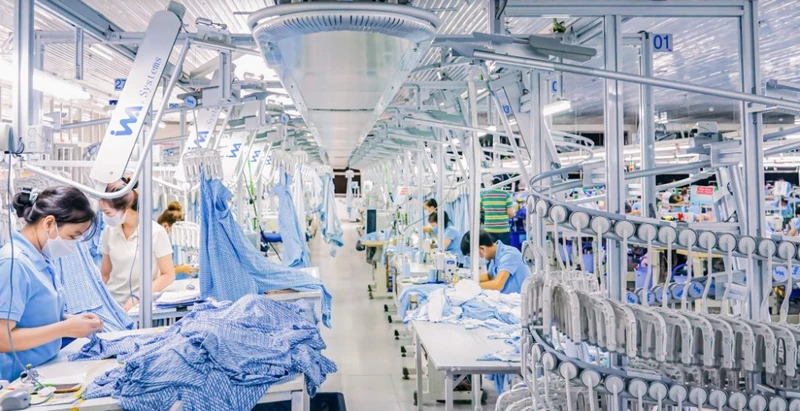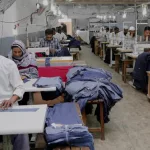In 2024, Vietnam surpassed Bangladesh to become the world’s second-largest textiles and apparel exporter
Vietnam has officially ascended to the position of the world’s second-largest textiles and apparel exporter, a landmark achievement reached in 2024. Surpassing Bangladesh, this milestone underscores Vietnam’s increasing dominance in the global market, with total export revenues hitting an impressive $44 billion. The nation now trails only China, the industry’s long-standing leader, firmly establishing itself as a pivotal player in the international textile and garment landscape.
This surge in export prowess is not a fleeting phenomenon. The Vietnamese textiles and garment industry is experiencing a powerful wave of export orders carrying strong momentum into 2025. This growth is fueled by a confluence of factors, including a positive economic outlook for the country and the industry’s inherent competitive advantages, solidifying Vietnam’s position as a key global market player. The sector began the year on a high note, posting $3.19 billion in exports in January, marking a 1.8 percent increase compared to the same period in the previous year. This growth is underpinned by robust demand from major international markets, most notably the United States, the European Union, and Japan.
The industry’s strong performance is reflected in the order books of major companies, with many reporting secured orders extending through the second quarter of 2025 and some even reaching into the third quarter. Than Duc Viet, General Director of Garment 10 Corporation, a significant player in the sector, highlighted this positive trend, stating, “Our company has secured significant orders for Q2 of 2025, setting a strong pace for the year”. Garment 10 is strategically expanding its market reach, focusing on traditional markets in the US, EU, and Japan, while simultaneously exploring new opportunities in South Korea, China, and other promising Asian nations. The company’s success in 2024, with $187.9 million in total revenue and $5.26 million in pre-tax profit (representing a 10 percent and 7 percent year-on-year increase, respectively), serves as a bellwether for the sector’s overall potential.
Other industry leaders echo this sentiment of growth and expansion. TNG Investment and Trading JSC has revealed that its factories are largely booked with orders through the second quarter, with 46 percent of its exports destined for the United States and 13 percent for the European Union. Song Hong Garment JSC, which directs over 70 percent of its exports to the US market, is planning a significant 25 percent expansion of its production capacity in 2025 to meet increasing demand. Thanh Cong Textile Investment Trading JSC has successfully fulfilled its Q1 order obligations and is now concentrating on fulfilling contracts for the second quarter. Looking ahead, the company is developing a strategic business plan focused on enhancing value for its shareholders and investors, with Asia currently accounting for the lion’s share of its exports (68 percent), followed by the Americas (27.4 percent) and Europe (4.2 percent). Vietnam National Textile and Garment Group, a state conglomerate, has also reported that several of its subsidiaries have secured orders through the third quarter of this year, with ongoing negotiations for additional contracts.
To capitalize on the rising demand, particularly for Spring-Summer collections, many companies have accelerated their production schedules to ensure timely order fulfillment, thereby sustaining the recovery momentum that began in late 2024.
However, the path forward is not without its challenges. According to SSI Research, the industry is projected to return to a compound annual growth rate of 13–15 percent in 2025, aligning with growth levels observed between 2015 and 2019. Rising shipping costs present a significant concern, with freight rates experiencing increases on key routes, including Asia to the US West Coast and East Coast. Overall transportation expenses are projected to increase by 10–15 percent year-on-year, which could potentially put pressure on profit margins despite the anticipated 15 percent revenue growth.
Despite these challenges, Vietnam’s textile and apparel industry possesses distinct competitive advantages. SSI Research points out that Vietnam benefits from tariffs that are 10–20 percent lower than those faced by China, coupled with significantly lower labor costs—less than half of China’s, where labor costs rose by 40 percent between 2019 and 2023.
Looking ahead to 2025, Vietnam’s textile and apparel industry is poised for continued expansion, leveraging its cost advantages, rapid production turnaround capabilities, and strong global demand. The industry’s ability to proactively manage rising logistics costs and adapt to the ever-shifting dynamics of international trade will be crucial in solidifying its prominent position in the fiercely competitive global market.






